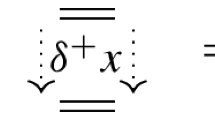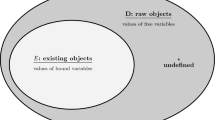Abstract
The essential interaction between classical and intuitionistic features in the system of linear logic is best described in the language of category theory. Given a symmetric monoidal closed category C with products, the category C×Cop can be given the structure of a *-autonomous category by a special case of the Chu construction. The main result of the paper is to show that the intuitionistic translations induced by Girard’s trips determine the functor from the free *-autonomous category A on a set of atoms {P,P′,...} to C × Cop, where C is the free monoidal closed category with products and coproducts on the set of atoms {P O , P I , P′ O , P′ I ,...} (a pair P O , P I in C for each atom P of A).
Research supported by EPSRC senior research fellowship on grant GL/L 33382. We wish to thank Martin Hyland for his essential suggestions and crucial support in the develoment of this work.
Access this chapter
Tax calculation will be finalised at checkout
Purchases are for personal use only
Preview
Unable to display preview. Download preview PDF.
Similar content being viewed by others
References
Samson Abramsky and Radha Jagadeesan. Games and Full Completeness for Multiplicative Linear Logic. J. Symb. Logic 59(2):543–574, 1994.
M. Barr. *-Autonomous categories, Lecture Notes in Mathematics 752, Springer-Verlag, 1979, Berlin, Heidelberg, New York.
M. Barr. *-Autonomous categories and linear logic, Mathematical Structures in Computer Science 1:159–178, 1991.
N. Benton, G. Bierman, V. de Paiva, M. Hyland. A term calculus for intuitionistic linear logic. Springer LNCS 664, pp. 75–90, 1993.
N. Benton, G. Bierman, V. de Paiva, M. Hyland. Linear λ-Calculus and Categorical Models Revisited, Preprint, Comp. Lab., Univ. of Cambridge.
G. M. Bierman. What is a Categorical Model of Intuitionistic Linear Logic? In Proceedings of the International Conference on Typed Lambda Calculi and Applications. April 10–12, 1995. Edinburgh, Scotland. Springer LNCS.
G. Bellin. Mechanizing Proof Theory: Resource-Aware Logics and Proof-Transformations to Extract Implicit Information, Phd Thesis, Stanford University. Available as: Report CST-80-91, June 1990, Dept. of Computer Science, Univ. of Edinburgh.
G. Bellin and P. J. Scott. Theor. Comp. Sci. 135(1): 11–65, 1994.
G. Bellin and J. van de Wiele. Subnets of Proof-nets in MLL−, in Advances in Linear Logic, Girard, Lafont and Regnier eds., London Math. Soc. Lect. Note Series 222, Cambridge University Press, 1995, pp. 249–270.
V. Danos and L. Regnier. The Structure of Multiplicatives, Arch. Math. Logic 28:181–203, 1989.
H. Devarajan, D. Hughes, G. Plotkin and V. Pratt. Full Completeness of the multiplicative linear logic of Chu spaces. Porceedings of LICS 1999.
Valeria C.V. de Paiva. The Dialectica Categories. PhD thesis. DPMMS, University of Cambridge, 1988. Available as Comp. Lab. Tech. Rep. 213, 1990.
A. Fleury. La règle d’échange. Thèse de doctorat, 1996, Équipe de Logique, Université de Paris 7, Paris, France.
A. Fleury and C. Retoré. The Mix Rule, Mathematical Structures in Computer Science 4:273–85, 1994.
H. N. Gabow and R. E. Tarjan. A Linear-Time Algorithm for a Special Case of Disjoint Set Union. Journal of Computer and System Science 30:209–221, 1985.
J-Y. Girard. Linear Logic, Theoretical Computer Science 50:1–102, 1987.
J-Y. Girard. On the unity of logic. Ann. Pure App. Log. 59:201–217, 1993.
J-Y. Girard. Proof-nets: the parallel syntax for proof-theory. In Logic and Algebra, New York, 1995. Marcel Dekker.
M. Hyland and L. Ong. Fair games and full completeness for Multiplicative Linear Logic without the Mix rule. ftp-able at theory.doc.ic.ac.uk in papers/Ong, 1993.
F. Lamarche. Proof Nets for Intuitionistic Linear Logic 1: Essential Nets. Preprint ftp-able from Hypatia 1994.
F. Lamarche. Games Semantics for Full Propositional Logic. Proceedings of LICS 1995.
R. Loader. Models of Lambda Calculi and Linear Logic: Structural, Equational and Proof-Theoretic Characterisations, PhD Thesis, St. Hugh’s College, Oxford, UK, 1994.
A. S. Murawski and C.-H. L. Ong. A Linear-time Algorithm for Verifying MLL Proof Nets via Lamarche’s Essential Nets. Preprint, OUCL, Wolfson Building, Parks Road, Oxford OX1 3QD, UK. andrzej@comlab.ox.ac.uk, http://www.comlab.ox.ac.uk/oucl/people/luke.ong.html, 1999.
A. Patterson. Implicit Programming and the Logic of Constructible Duality, PhD Thesis, University of Illinois at Urbana-Champaign, 1998. http://www.formal.stanford.edu/annap/www/abstracts.html#9
V. Pratt. Chu spaces as a semantic bridge between linear logic and mathematics. Preprint ftp-able from http://boole.stanford.edu/chuguide.html, 1998.
A. Tan. Full completeness for models of linear logic. PhD Thesis, King’s College, University of Cambridge, UK, October 1997.
Author information
Authors and Affiliations
Editor information
Editors and Affiliations
Rights and permissions
Copyright information
© 2003 Kluwer Academic Publishers
About this chapter
Cite this chapter
Bellin, G. (2003). Chu’s Construction: A Proof-Theoretic Approach. In: de Queiroz, R.J.G.B. (eds) Logic for Concurrency and Synchronisation. Trends in Logic, vol 15. Springer, Dordrecht. https://doi.org/10.1007/0-306-48088-3_2
Download citation
DOI: https://doi.org/10.1007/0-306-48088-3_2
Publisher Name: Springer, Dordrecht
Print ISBN: 978-1-4020-1270-9
Online ISBN: 978-0-306-48088-1
eBook Packages: Springer Book Archive




